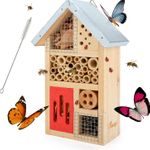So deer have carved their way into your arborvitae (Thuja spp. and cvs., Zones 2–8), rhododendron (Rhododendron spp. and cvs., Zones 3–11), or yew (Taxus spp. and cvs., Zones 5–8). This is an all-too-common sight that many gardeners have encountered at least once or twice, and it can be a devastating setback. Is there anything you can do to help a plant recover from this? How can you prevent further damage? And how do you know when to just throw in the towel? The answer depends on the plant.
Some Plants Recover and Some Don’t
Some broadleaf evergreens such as rhododendrons, hollies (Ilex spp. and cvs., Zones 5–9), and boxwoods (Buxus spp. and cvs., Zones 4–9) are tolerant of heavy pruning. This resilience often means that they can bounce back after browsing by deer. You can wait for browsed sections to regrow, or research how much cutting back your plant can take and shape the rest of the plant accordingly to disguise damaged sections. But regrowth can be even more tasty and tempting and must be protected from further munching.
Conifers are less likely to bounce back, with some exceptions, such as yews, which can regrow even from bare branches. Arborvitaes can recover from deer browsing in time if the damage is minor and there are still green leaves on the wood, but if the branches are bare, they will likely stay that way. Similar to broadleaf evergreens, some shaping and pruning of these plants can help disguise damage and promote new growth.

Conifers are less likely to bounce back, with some exceptions, such as yews, which can regrow even from bare branches. Arborvitaes can recover from deer browsing in time if the damage is minor and there are still green leaves on the wood, but if the branches are bare, they will likely stay that way. Similar to broadleaf evergreens, some shaping and pruning of these plants can help disguise damage and promote new growth.
Protect plants from further damage
Physical barriers, such as burlap or deer fencing, can keep deer away from prized plants, but they may obscure the aesthetic effect of your evergreens. The most efficient physical deterrent, cost permitting, would be to completely fence in your garden. A common mistake gardeners make is installing a fence around their property that is too short. A fence needs to be at least 8 feet tall to keep deer out.
Deterrent sprays can work if reapplied regularly. If your area has an organic deer-resistant-spray service, sign up. Many of these services work wonders if applied one to two times per month and are often more effective than store-bought sprays that you would apply yourself since they are more rain resistant. Eventually, the herd will move on to a tastier landscape.
| Tip |
Protect Your Evergreens from Buck Rub
: Prior to breeding season in fall, bucks rub their antlers against trees, which can strip bark in a vertical pattern. If buck rub encircles them completely, those trees will likely die. There are specific tapes you can use to protect previously targeted trees. You can also cut off lengths of corrugated drainage pipe and put them around the trunks. Use these protective measures from early fall until spring.
Fine Gardening Recommended Products

Greenworks 40V 14″ Chainsaw, 2.5Ah USB Battery and Charger Included
Fine Gardening receives a commission for items purchased through links on this site, including Amazon Associates and other affiliate advertising programs.
14” CHAIN AND BAR : great performance for tree cutting and get up to 75 cuts on 4×4 lumber on a single charge. TRUBRUSHLESS MOTOR TECHNOLOGY: 2 x more torque. Provides more power, longer runtimes, quiet operation, and extended motor life. AUTOMATIC OILER: delivers proper chain lubrication and increased productivity. EASY ADJUST TENSIONING: for easy bar and chain maintenance. EASY TO USE : push button start, no gas or fumes, no carburetor, no spark plug, and no starter rope WHAT IS INCLUDED: 40V 14-Inch chainsaw, scabbard, 2.5 Ah batteries, fast charger, operator’s manual.

Niteangel Natural Wooden Insect Hotel, Garden Insect House for Ladybugs, lacewings, Butterfly, Bee, Bug
Fine Gardening receives a commission for items purchased through links on this site, including Amazon Associates and other affiliate advertising programs.
The insect nest box provide a safe environment where garden creatures can shelter, hibernate and lay their eggs, the insect house can also keep insects from entering your warm room. The insect hotel makes it easy to find and observe fascinating creatures. the butterfly, bees and ladybugs can use this product as habitat. Dry wood and Bamboo can be home to many insects such as ladybirds and lacewings which eat aphids and help keep your plants pest-free. the insect hotel improve the growth of plants in your yard by attracting beneficial insects. The iron design on the top can keep the insect house from rainwater. Let the insect house have a longer useful life and make the insects more comfortable. If you only have a balcony or yard, the hanging garden shelter is ideal as it provides a choice of suitable habitats in a small area.